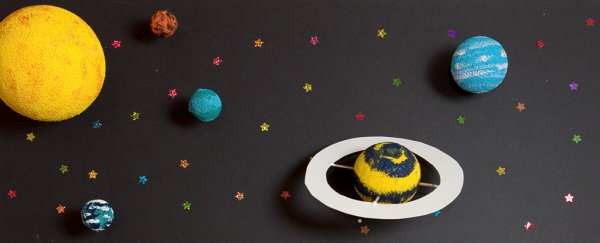Space offers plenty of mysteries for astronomers to solve, and there's one in our own Solar System that's been unexplained for decades: why are Venus and Uranus spinning in different directions to the other planets around the Sun?
Venus spins on its axis from east to west, while Uranus is tilted so far over, it's virtually spinning on its side. Every other planet, including our own, spins from west to east, and scientists haven't figured out why.
The planets should really all be spinning the same way: our Solar System was formed by a collapsing and rotating cloud of gas, and it's thought that the spin direction of most planets (like Earth) has been carried over from that ancient rotation.
But Venus and Uranus are the exceptions: they have what's known as retrograde rotation, spinning counter to the rotation of the Sun. But how is this possible?
One of the most long-standing hypotheses is that Venus and Uranus originally rotated counter-clockwise – like Earth and the other planets still do – but were struck at some point by massive objects (perhaps other planets) that sent them spinning in different directions.
In recent years, astronomers have looked for other explanations, examining Venus and Uranus independently.
In 2011, simulations suggested that a number of smaller collisions, rather than one big impact, knocked Uranus' spin to an angle of 98 degrees. This could also explain why the planet's moons rotate at the same angle – something that would be unlikely if there were just one massive hit.
An alternative explanation put forward by astronomers in 2009 is that Uranus once had a large moon, the gravitational pull of which caused the planet to fall on its side. Eventually, the moon could have been knocked out of orbit by another planet, a bit like a game of cosmic pinball.
As for Venus, our closest neighbour, scientists have suggested that it started off rotating counter-clockwise, then slowed down to be almost static, before starting to spin clockwise like it does now.
This might explain the planet's very slow rotation speed today – it takes Venus 243 Earth days to rotate fully, but only 225 Earth days to orbit the Sun. So if you lived on Venus, your days would be longer than your years (and the Sun would rise in the west).
How does that happen to a planet? Astronomers think that the Sun's strong gravitational pull on the dense atmosphere of Venus; the atmospheric tides that would create; and the tidal pulls from other planets, could all have combined to reverse the planet's spin.
This idea of tidal torques – where the dense atmosphere on the warm, Sun-drenched side of a planet is pulled away from the cold side – is one of the most well-established explanations for Venus' retrograde rotation, along with a planetary collision.
For now though, no one's 100 percent sure what makes Venus and Uranus the odd ones out in our Solar System's family of planets.
Our next close look at Venus should come from a flyby with the BepiColombo probe, which is eventually headed for Mercury and launching in 2018.
That mission might give us new data to help solve the mystery – and we'll be watching closely.
